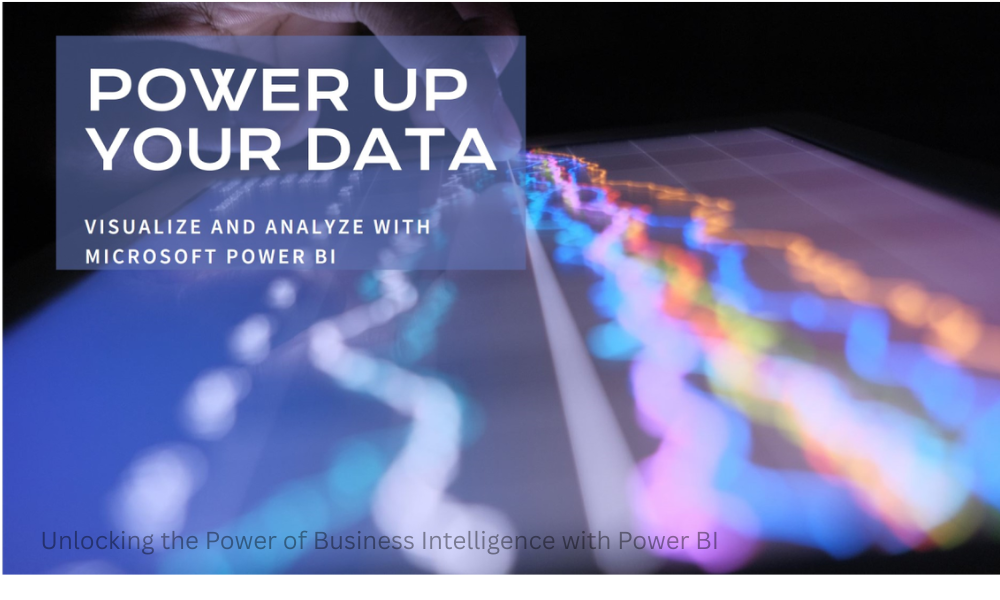Unlocking the Power of Business Intelligence with Power BI

Introduction
Unlocking the Power of Business Intelligence with Power BI In today’s fast-paced digital world, making informed decisions is the backbone of any successful business. That’s where business intelligence (BI) comes into play. And when paired with Power BI, Microsoft’s top-tier analytics tool, businesses can transform raw data into strategic insights. If you’re here to understand what business intelligence Power BI means and how it benefits your business, you’ll find your answer right from the start—and everything else that helps you master it in this guide.
Table of Contents
What is Business Intelligence (BI)?
Business Intelligence refers to technologies and strategies used by enterprises to analyze business data. It helps organizations make data-driven decisions by transforming complex datasets into actionable insights.
Think of BI as your business’s sixth sense—it collects, processes, and interprets data so you can see trends, improve operations, and grow smarter.
Introduction to Power BI
Power BI is a powerful business analytics tool developed by Microsoft. It allows you to visualize your data and share insights across your organization. With intuitive dashboards, interactive reports, and AI capabilities, Power BI turns data into stunning visuals and real-time answers.
Why do businesses love Power BI?
- It’s easy to use
- Cloud-based and highly scalable
- Seamlessly integrates with Excel, Azure, and other Microsoft tools
Why Combine Business Intelligence with Power BI?
Using Power BI for business intelligence isn’t just smart—it’s transformative. You get real-time data analysis, customizable dashboards, and AI-enhanced visualizations in one package.
Power BI empowers businesses to:
- Make quicker decisions
- Identify patterns and risks
- Track KPIs in real-time
- Collaborate effortlessly across departments
Key Features of Power BI
Power BI Desktop
Create stunning reports on your desktop with drag-and-drop functionality and built-in data connectors.
Power BI Service
A cloud-based platform to share, collaborate, and publish reports.
Power BI Mobile
Access dashboards on the go with apps for Android, iOS, and Windows.
Power BI Embedded
Integrate Power BI visuals directly into custom applications.
Components of Power BI
Datasets
The raw data source that feeds your reports and dashboards.
Reports
Multi-page documents filled with visualizations based on your datasets.
Dashboards
Single-page, real-time panels that showcase the key metrics at a glance.
Dataflows
Enable data transformation and preparation within the Power BI ecosystem, streamlining data modeling.
How Power BI Works
- Connect to Data: Whether it’s Excel, SQL Server, or cloud services like Google Analytics—Power BI connects to it all.
- Transform Data: Use Power Query to clean, shape, and model your data without needing code.
- Create Visualizations: With intuitive drag-and-drop features, create charts, graphs, and interactive visuals.
- Share and Collaborate: Publish to the Power BI Service and allow others in your team to view or interact with your reports.
Advantages of Using Power BI for Business Intelligence
Real-Time Data Access
Make decisions on the fly with live dashboards.
Custom Visuals
Choose from hundreds of visuals or import custom-built charts that fit your unique needs.
AI-Powered Insights
Use natural language queries and machine learning to discover trends.
Microsoft Integration
Seamlessly works with Excel, Teams, SharePoint, and Azure.
Power BI vs Other BI Tools
Power BI vs Tableau
Power BI is more affordable and integrates deeply with Microsoft tools, while Tableau is praised for its high-end visualizations.
Power BI vs QlikView
QlikView offers strong associative analytics, but Power BI wins on ease of use and cloud capabilities.
Power BI vs Google Data Studio
While Google’s solution is free and browser-based, Power BI offers more advanced BI features and enterprise-ready scalability.
Common Use Cases in Business Intelligence with Power BI
Sales Analytics
Track sales performance, targets, and customer trends.
Financial Reporting
Build custom P&L reports, cash flow analysis, and budgeting dashboards.
HR Dashboards
Monitor employee performance, turnover, and training progress.
Customer Behavior Analysis
Understand buying patterns, engagement levels, and churn risks.
Learning Power BI for Business Intelligence
New to Power BI? You’re not alone.
Start with:
- Microsoft’s official learning paths
- YouTube tutorials
- Platforms like Coursera, Udemy, or LinkedIn Learning
- Power BI Community forums and blogs
Certifications like DA-100: Analyzing Data with Microsoft Power BI can boost your credibility.
Power BI for Small and Medium Businesses
You don’t need a massive IT team to use Power BI. Even small businesses can benefit from:
- Low-cost implementation
- Quick report generation
- Custom dashboards tailored to business goals
Challenges of Using Power BI
It’s not all rainbows. Some hurdles include:
- Learning Curve: Some advanced features need time to master
- Data Governance: Managing permissions and security protocols can be complex
- Performance with Big Data: Large datasets may need data modeling optimization
Future of Business Intelligence with Power BI
Power BI is continuously evolving with AI, machine learning, and predictive analytics becoming core features. Expect to see more:
- Automated insights
- Natural language generation
- Integration with IoT and big data tools
The future is about smart dashboards that think ahead of you.
Conclusion
If you’re serious about growing your business and making data-driven decisions, combining business intelligence Power BI is the perfect path forward. It simplifies complex data, enables smarter strategies, and keeps your organization ahead of the competition. Whether you’re a startup or a large enterprise, Power BI is a tool you can’t afford to ignore.
FAQs
Is Power BI easy to use for beginners?
Yes, Power BI offers an intuitive interface, drag-and-drop features, and plenty of beginner-friendly tutorials.
Can Power BI handle large datasets?
Yes, but you may need to optimize your data models and use DirectQuery or Aggregations for better performance.
Is Power BI free?
Power BI Desktop is free. Power BI Pro and Premium offer more features and collaboration tools at a cost.
How is Power BI used in business intelligence?
It is used to analyze, visualize, and share data in real time, making informed decision-making easier.
Can I use Power BI without coding?
Absolutely. Most tasks like creating visuals and reports are code-free. However, DAX formulas can enhance functionality for advanced users.






